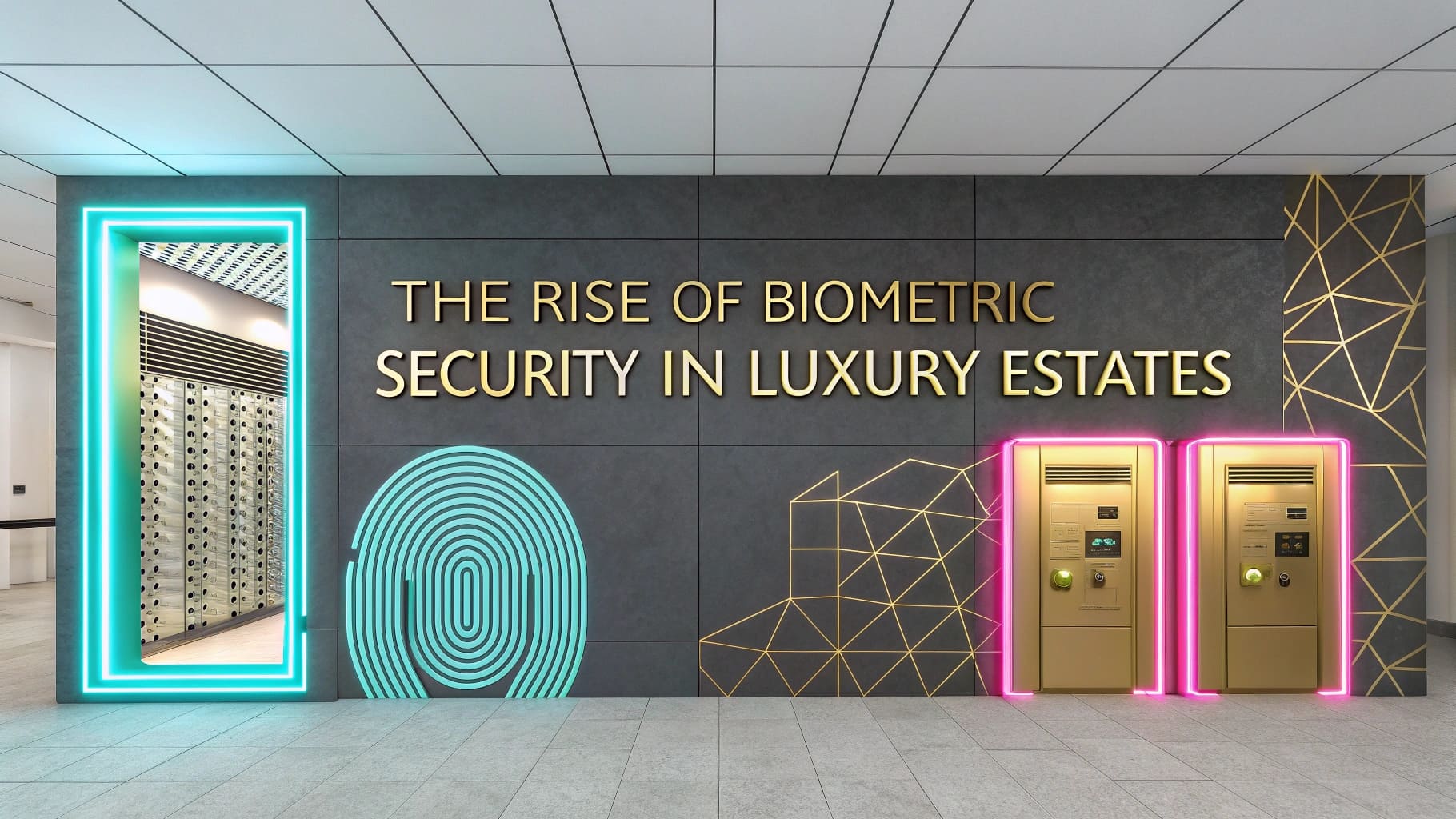Biometric security has emerged as a revolutionary approach to safeguarding personal and property security, particularly in high-value environments such as luxury estates. This technology leverages unique biological traits—such as fingerprints, facial recognition, iris patterns, and voice recognition—to authenticate individuals. Unlike traditional security measures, which often rely on passwords or physical keys that can be lost or stolen, biometric systems provide a more robust and reliable means of access control.
The increasing sophistication of biometric technology has made it an attractive option for luxury estate owners who seek to enhance their security measures while also providing convenience and ease of access. The evolution of biometric security can be traced back to the early 20th century when fingerprinting was first used in criminal investigations. Today, advancements in technology have expanded the scope of biometrics to include a variety of modalities that can be integrated into comprehensive security systems.
The luxury real estate market, characterized by high-value properties and affluent clientele, has become a prime candidate for the adoption of these advanced security solutions. As concerns about safety and privacy continue to grow, the integration of biometric systems into luxury estates represents a proactive approach to addressing these challenges.
Benefits of Biometric Security in Luxury Estates
Unparalleled Convenience
In addition to security, biometric systems offer unparalleled convenience. Homeowners no longer need to fumble for keys or remember complex passcodes; instead, they can gain access through a simple scan of their fingerprint or a quick facial recognition check. This ease of use is particularly beneficial in high-end properties where multiple access points may exist.
Seamless Integration and Management
Moreover, many biometric systems can be integrated with smart home technologies, allowing for seamless control over various aspects of the estate—from lighting and climate control to security cameras and alarms—through a single interface. This integration not only enhances the user experience but also streamlines the management of the estate’s security features.
Types of Biometric Security Systems
Biometric security systems can be categorized into several types based on the biological traits they utilize for identification and authentication. Fingerprint recognition is one of the most widely adopted forms of biometric security due to its reliability and ease of use. Fingerprint scanners can be installed at entry points such as doors or gates, allowing for quick access while maintaining a high level of security.
These systems can also store multiple fingerprints, accommodating family members and staff without compromising safety. Facial recognition technology has gained significant traction in recent years, particularly with advancements in artificial intelligence and machine learning. This system analyzes facial features and compares them against a database to verify identity.
In luxury estates, facial recognition can be employed not only for access control but also for monitoring visitors and identifying potential threats in real-time. Additionally, iris recognition is another sophisticated biometric method that uses patterns in the iris to authenticate individuals. While less common than fingerprint or facial recognition, iris scanners offer an extremely high level of accuracy and are increasingly being integrated into high-security environments.
Voice recognition is another emerging biometric technology that is gaining popularity in luxury estates. This system analyzes vocal characteristics to authenticate users, allowing homeowners to control various smart home features through voice commands. While voice recognition may not yet be as widely implemented as other biometric methods, its potential for integration with home automation systems makes it an appealing option for tech-savvy luxury estate owners.
Implementation of Biometric Security in Luxury Estates
Implementing biometric security systems in luxury estates involves several critical steps that ensure both effectiveness and user acceptance. The first step is conducting a comprehensive security assessment to identify vulnerabilities within the property. This assessment should consider various factors such as the layout of the estate, existing security measures, and potential threats specific to the location.
By understanding these elements, estate owners can make informed decisions about which biometric systems will best meet their needs. Once the assessment is complete, selecting the appropriate biometric technology becomes paramount. Factors such as the size of the estate, the number of residents and staff, and the desired level of security will influence this decision.
For instance, a sprawling estate with multiple entry points may benefit from a combination of fingerprint scanners at main entrances and facial recognition cameras throughout the property. Additionally, integrating these systems with existing security infrastructure—such as alarm systems and surveillance cameras—can create a cohesive security network that enhances overall protection. Training residents and staff on how to use biometric systems effectively is another crucial aspect of implementation.
Ensuring that everyone understands how to operate the technology not only maximizes its effectiveness but also fosters a sense of comfort among users. Regular maintenance and updates are also essential to keep the systems functioning optimally and to address any potential vulnerabilities that may arise over time.
Privacy and Data Protection Concerns
While biometric security offers numerous advantages, it also raises important privacy and data protection concerns that must be addressed by luxury estate owners. The collection and storage of biometric data—such as fingerprints or facial images—pose significant risks if not managed properly. Unauthorized access to this sensitive information could lead to identity theft or misuse, making it imperative for estate owners to implement robust data protection measures.
To mitigate these risks, luxury estates should adopt best practices for data encryption and storage. Biometric data should be stored securely using advanced encryption techniques that render it unreadable without proper authorization. Additionally, implementing strict access controls ensures that only authorized personnel have access to sensitive information.
Regular audits and assessments can help identify potential vulnerabilities in data management practices, allowing for timely interventions. Furthermore, transparency with residents about how their biometric data will be used is essential for building trust. Estate owners should provide clear information regarding data collection practices, storage duration, and any third-party sharing policies.
Establishing a privacy policy that outlines these practices can help alleviate concerns among residents while ensuring compliance with relevant data protection regulations.
Future Trends in Biometric Security for Luxury Estates
As technology continues to evolve, so too will biometric security systems in luxury estates. One notable trend is the increasing integration of artificial intelligence (AI) into biometric technologies. AI can enhance the accuracy and efficiency of biometric recognition processes by learning from user behavior patterns and adapting to changes over time.
For instance, AI-powered facial recognition systems can improve their accuracy by continuously updating their databases with new images, ensuring that they remain effective even as residents age or change their appearance. Another emerging trend is the development of multi-modal biometric systems that combine different types of biometric authentication methods for enhanced security. For example, a system that requires both fingerprint scanning and facial recognition could provide an additional layer of protection against unauthorized access.
This approach not only increases security but also addresses potential weaknesses inherent in relying on a single biometric modality. Moreover, as smart home technologies become increasingly prevalent in luxury estates, the integration of biometric security with Internet of Things (IoT) devices will likely become more common. Homeowners may soon be able to control various aspects of their estate—from lighting to climate control—through biometric authentication methods, creating a seamless user experience that enhances both convenience and security.
Case Studies of Luxury Estates with Biometric Security
Several luxury estates around the world have successfully implemented biometric security systems, showcasing their effectiveness in enhancing safety and convenience for residents. One notable example is a high-end residential community in Dubai that utilizes facial recognition technology at its main entrance gates. This system not only allows residents quick access but also monitors visitors entering the community in real-time, providing an added layer of security against potential threats.
Another case study involves a luxury estate in California that has integrated fingerprint scanning technology throughout its property. Each family member has their fingerprint registered in the system, allowing them easy access to various areas within the estate without needing physical keys or codes. This implementation has significantly reduced instances of unauthorized access while providing peace of mind for the homeowners.
In Europe, a luxury villa in France has adopted a multi-modal biometric system that combines both facial recognition and voice authentication for its entry points. This innovative approach ensures that only authorized individuals can gain access while also allowing residents to control smart home features through voice commands. The integration of these technologies has not only enhanced security but also elevated the overall living experience within the estate.
The Impact of Biometric Security on the Luxury Real Estate Industry
The impact of biometric security on the luxury real estate industry is profound and multifaceted. As affluent homeowners increasingly prioritize safety and convenience, the adoption of advanced biometric technologies has become essential for maintaining competitive advantage in this market segment. By providing enhanced security measures that are both user-friendly and efficient, luxury estates can cater to the evolving needs of their residents while addressing growing concerns about privacy and data protection.
As biometric technology continues to advance, its integration into luxury estates will likely become more sophisticated and widespread. The future promises exciting developments that will further enhance both security and convenience for homeowners, solidifying biometrics as a cornerstone of modern luxury living. The ongoing evolution of this technology will undoubtedly shape the landscape of luxury real estate for years to come, making it an area ripe for innovation and growth.
FAQs
What is biometric security?
Biometric security refers to the use of unique physical or behavioral characteristics, such as fingerprints, facial recognition, or iris scans, to verify a person’s identity for security purposes.
How is biometric security being used in luxury estates?
Biometric security is being used in luxury estates to provide a high level of security and convenience for residents and guests. This can include using biometric access control systems for entry into the estate, as well as for access to individual homes and amenities within the estate.
What are the benefits of biometric security in luxury estates?
The benefits of biometric security in luxury estates include enhanced security, as biometric identifiers are unique to each individual and difficult to replicate. Biometric security also offers convenience, as residents and authorized individuals can access the estate and their homes without the need for keys or access cards.
Are there any privacy concerns with biometric security in luxury estates?
There may be privacy concerns with biometric security in luxury estates, as the collection and storage of biometric data raises potential privacy risks. It is important for estate developers and managers to implement robust data protection measures and ensure compliance with relevant privacy regulations.
What are some examples of biometric security technologies used in luxury estates?
Examples of biometric security technologies used in luxury estates include fingerprint scanners, facial recognition systems, iris scanners, and palm vein recognition. These technologies can be integrated into access control systems for gates, doors, and other entry points within the estate.

